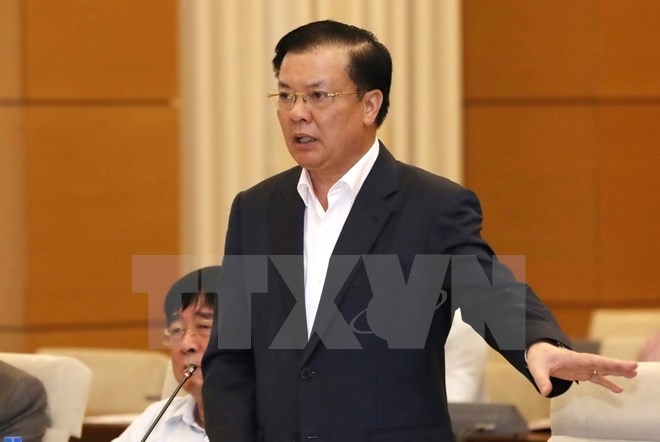 Politics & Law
Politics & Law

Thrift and anti-waste work in 2016 was discussed at the ninth session of the 14th National Assembly Standing Committee in Hà Nội yesterday.
 |
| Minister of Finance Đinh Tiến Dũng delivers speech at the ninth session of the 14th National Assembly Standing Committee in Hà Nội yesterday. — VNA/VNS Photo Phương Hoa |
HÀ NỘI — Thrift and anti-waste work in 2016 was discussed at the ninth session of the 14th National Assembly Standing Committee in Hà Nội yesterday.
According to a Government report, under the leadership of the Party, the supervision of the National Assembly, the management of the Government, the Prime Minister and efforts of ministries, positive changes have been reported in all fields, including the purchase of equipments and vehicles for government organisations.
Some 73 ministries and agencies have announced their list of purchases and followed state regulations.
Ministries, agencies and localities have improved management of the construction and upgrading of their offices.
As of December last year, declarations were reported on more than 154,000 houses and land plots owned by government organisations. The money collected from selling assets or rearranged land use rights hit more than VNĐ50 trillion (US$2.2 billion).
Presenting the Government report, Minister of Finance Đinh Tiến Dũng said that the implementation of Resolution No 39-NQ/ TW of the Politburo on streamlining staffing and restructuring cadres and civil servants achieved some initial positive results.
The use of information technology in administrative agencies and public administrative services also proved effective.
However, he said, there were still shortcomings in staff.
The recruitment and appointment of civil servants in some state agencies didn’t follow regulations, with loose management resulting in more violations.
Regarding the government’s anti-waste programme, Nguyễn Đức Hải, chairman of the NA’s Financial and Budget Committee, said several localities have used large amounts of money from local budgets to celebrate their provinces’ founding anniversary.
"This is a waste of funds," Hải said.
Vĩnh Phúc Province, for example, spent VNĐ65 billion on buying gifts for guests and the local people on its anniversary, he said.
Hải also said that there was big waste in the use of investment for capital construction.
Some ministries and localities did not follow regulations on the allocation of investment capital. They allocated funds for projects that did not meet approved criteria which wasted time and capital, he said.
Total outstanding debt for capital construction from the central budget was VNĐ9.5 trillion by the end of the year 2016, according to the report.
The management of investment projects and the exploitation of transport works in the form of Build-Operate-Transfer (BOT) still faces many obstacles, Hải said.
The State Audit found that 11 out of 27 projects made mistakes in cost estimations, resulting in a spike of VNĐ465.5 billion compared with originally estimated costs.
While applauding the government’s efforts in thrift practice and anti-waste, NASC deputies suggested the need to improve monitoring of the implementation of the Law on Thrift Practice and Waste Prevention, especially in construction investment, management and use of land, natural resources, purchasing and use of public assets.
The Government, agencies and localities should improve the awareness and responsibility of officials, public servants, labourers on the Law of thrift practice and Waste Prevention, they said.
The deputies said the Government should improve the quality of planning and tighten the management of land.
Strict punishments should be imposed on all violations relating to the implementation of thrift practice work, such as wastefulness in using public cars or the State budget.
Sầm Sơn Town becomes city
With the majority of approval, Sầm Sơn Town in the north central coastal province of Thanh Hóa was promoted to city status at the NASC yesterday morning.
Deputies also agreed with the establishment of four wards, namely Quảng Cư, Quảng Châu, Quảng Thọ, and Quảng Vinh in Sầm Sơn.
The move aims to develop it into a national tourist city.
It also looks to create a development of an economic triangle, encompassing Thanh Hóa City, Sầm Sơn City, and Nghi Sơn Economic Zone, which will be an important driving force for socio-economic growth in the province.
Sầm Sơn City will cover 44.94 square kilometers with a population of 150,902 and 11 communal administrative units.
While most of deputies agreed with the government’s plan, some deputies expressed concerns over its economic, social and environment impact.
Deputy Chairman of National Assembly Tòng Thị Phóng proposed that attention be paid to changing jobs for local residents and to environmental protection.
Given the fact that Thanh Hóa Province can not balance its budget, Chairman of the NA’s Committee for Legal Affairs Nguyễn Khắc Định suggested that more capital should be mobilised from central budget for Sầm Sơn City’s infrastructure development. — VNS




